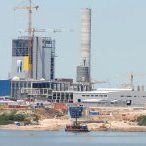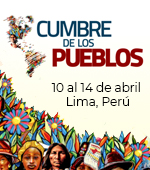
16 de diciembre de 2009 | Informes especiales | Justicia climática y energía
CDM in Uruguay: The case of Botnia
9:08 minutes
Descargar: MP3 (4.2 MB)
Botnia, a Finnish company, was founded in 1973 and is present in Finland with four pulp mills. It is the world´s second producer of cellulose pulp, and Uruguay is the only country of South America where the company is operating. It belongs to Finnish forestry company Metsäliitto and pulp mills M-Real Oyj and UPM-Kymmene Oyj.
Until July, 2009, these three companies owned Forestal Oriental (FOSA), one of the largest owners of forestry plantations in Uruguay, but after a financial operation, UPM acquired FOSA´s shares, and 91 per cent of the plant in Uruguay, in Fray Bentos city.
From January to March, 2009, Botnia´s sales in Uruguay amounted to 302.8 million Euros, while in the same period in 2008 the sales amounted to 397.0 million. Investments fell from 23.3 to 10.2 million Euros in that period. The company said this was due to the weakening market situation and the price of pulp.
In March this year, Botnia reported that the International Financial Corporation of the World Bank published the results of an environmental assessment carried out after one year of the plant´s presence in Fray Bentos, the source of a diplomatic conflict between Argentina and Uruguay.
The study conducted by EcoMetrix states that the operations of the plants are in agreement with strict environmental regulations and that the emissions as well as the effluents are under the levels established by Uruguayan authorities. According to the report, the operation of the plant has not affected the quality of the water in Uruguay River, or the quality of the air in the region.
But there´s a background to this situation. Forestal Oriental is one of the largest owners of forestry plantations of Uruguay. A report written by REDES-Friends of the Earth Uruguay in May, 2008, showed that the company was producing one million cubic meters of wood.
Botnia´s investment in Uruguay amounted to 1.1 billion dollars and the company was expecting to gain back that figure in less than three years, with the profits obtained from the production of cellulose pulp only, that is without including the profits obtained from selling electric power to Uruguay.
This implies the generation, from biomass, of a surplus of electric power of 33 megawatts. In order to do this, the plant uses a black liquid, obtained from the elaboration of cellulose pulp, to produce steam and electricity. The plant was designed to produce electric power, which differentiates it from other plants. In addition, the plant can transfer the energy to the national energy network and also to Kemira, a chemical plant located near Botnia.
The CDM was an essential part of the preparation of the cellulose project of Botnia, and was taken into account by the end of 2004 when it was still in its planning stage. The Finish company conducted CDM studies in November-December, 2004, to research on the possibility of using carbon finance as a way of generating profits through selling electricity.
The investment became a reality in 2005, when Botnia´s Board of Directors accepted the CDM as an important financial tool, according to the minutes of their meeting. The CDM project would reduce green house gases emissions for Botnia with the partial replacement of fossil fuels with a renewable fuel, in this case biomass, although it was later made clear that without the additional incentives granted by the CDM , this project wouldn´t be possible.
Other possible benefits of the CDM for Botnia are the sale of certificates; becoming the first independent institution to generate electric power in Uruguay, and contributing to the energy security of the country. According to the Project Design, the implementation of the CDM has positive environmental impacts. This issue has been present throughout the history of the settling of the company in Fray Bentos.
There, waste and effluents are processed by a biological treatment plant that does not have negative impacts on the organisms living in the river. To mitigate the impacts of solid waste the project has its own dumping site; and the quality of the air emissions is kept in appropriate levels, according to EU standards.
The emission of smells, always according to the company, is below the required levels, although the concentration of substance can increase without affecting the health of the population. In the building stage, dust emissions were expected, and it is worth mentioning that several workers suffered health problems due to the emanation coming from the plant.
The form also makes reference to the increase of noise and traffic during the building stage, and the modification of the landscape, caused by the steam of the chimneys, and also by the trucks transporting wood.
In November, 2006, the Uruguayan government authorized Botnia to obtain the double of water from Uruguay River that had been agreed. A few months before, the University of the Republic warned about the effects of that action on the river, stating that these would be very strong.
Nobody can deny the impact of tree monoculture plantations on water sources: especially in the West-Center region of the country, where empty fields and desertified soils can be seen. The producers of the area state that in 1995 wells and streams started to dry up and it is possible to prove that water wells that supplied entire populations are dry today.
This is the case of the city of Mercedes, where 200 families have to be supplied with water by tank trucks. Washington Lockhart, a milk producer of the area, said that this has caused a depopulation of the countryside. “These big forestry companies buy the fields, and the first thing they do is to knock down the houses. This makes it impossible for people to live there”, he added.
Summing up, forestry and soy monoculture plantations have had a strong impact on the ecosystem which is the basis of agriculture and food for the country. This goes hand in hand with the process of land concentration and foreignization that is taking place: today, more than half of the forested land in Uruguay is owned by a few transnational corporations, such as Weyerhaeuser from the US, Stora Enso from Sweden and Finland, Arauca from Chile, and Botnia itself.
Spanish company ENCE, present in Uruguay with lands and plantations, sold their operations in Uruguay to Stora Enso and Arauco for 344 million dollars in May, 2009. This transaction created the largest private extension of land in the history of Uruguay: 250,000 hectares of land in the hands of two companies.
With the investment of Stora Enso and Portuguese Portucel, Uruguay would reach three million hectares planted with tree monocultures. If with one million hectares the consequences are notorious, we don´t need much to estimate what would happen with three times more. The scale of the problem has been acknowledged by authorities of the Ministry of Livestock, Agriculture and Fisheries, who have raised the need of applying measures to stop this process.
The installation of Botnia has changed forever the production model of Uruguay and the region. On one side, it consolidated the forestry sector, and on the other it has wounded to death the possibility of achieving food sovereignty.
Milk production, which has difficulties accessing water, and beekeeping, which is affected by agrotoxic products, are two of the sectors most impacted by these “green deserts”, which can only coexist with the agribusiness model.
The outlook tends to be complex and disheartening: ecological and social debt, profits exclusive to companies, labour exploitation, and over-use of agrotoxics with impacts on the health of workers and the population. Until now, several studies have concluded that the expectations around the source of jobs Botnia would provide have not been fulfilled, while the goals set with reference to the CDM are far from keeping the promises made.
Gerardo Honty, from the Uruguayan Center of Appropriate Technologies warned about the weaknesses of the mechanism.“In the case of CDM in Botnia the assumption to create the base line was that all new incorporations to generate electric power in Uruguay would be based on fossil fuels”
However, as Honty explains, shortly after authorizing the CDM of Botnia, the Uruguayan Ministry of Industry, Energy and Mining submitted a plan for the incorporation of 500 megawatts based on renewable sources by 2015: wind power, water and biomass, which would amount to 25 per cent of the installed capacity of the country.
Honty stated that it is unlikely that the authorized project will reduce effectively all emissions, and explained that the other “big mistake” of the CDM with reference to Botnia is assuming that without the project (that is if the company didn´t have the additional funding provided by the sale of carbon certificates) the plant would have had a “conventional”and less efficient heating system.
Analyzing the data from the economic and financial assessment of the project, the difference between implementing new technology and implementing “conventional” technology represents, according to the researcher, a net benefit for the company worth approximately 15 million dollars, without it representing any additional reduction of emissions compared to that which would have occurred without the project.








